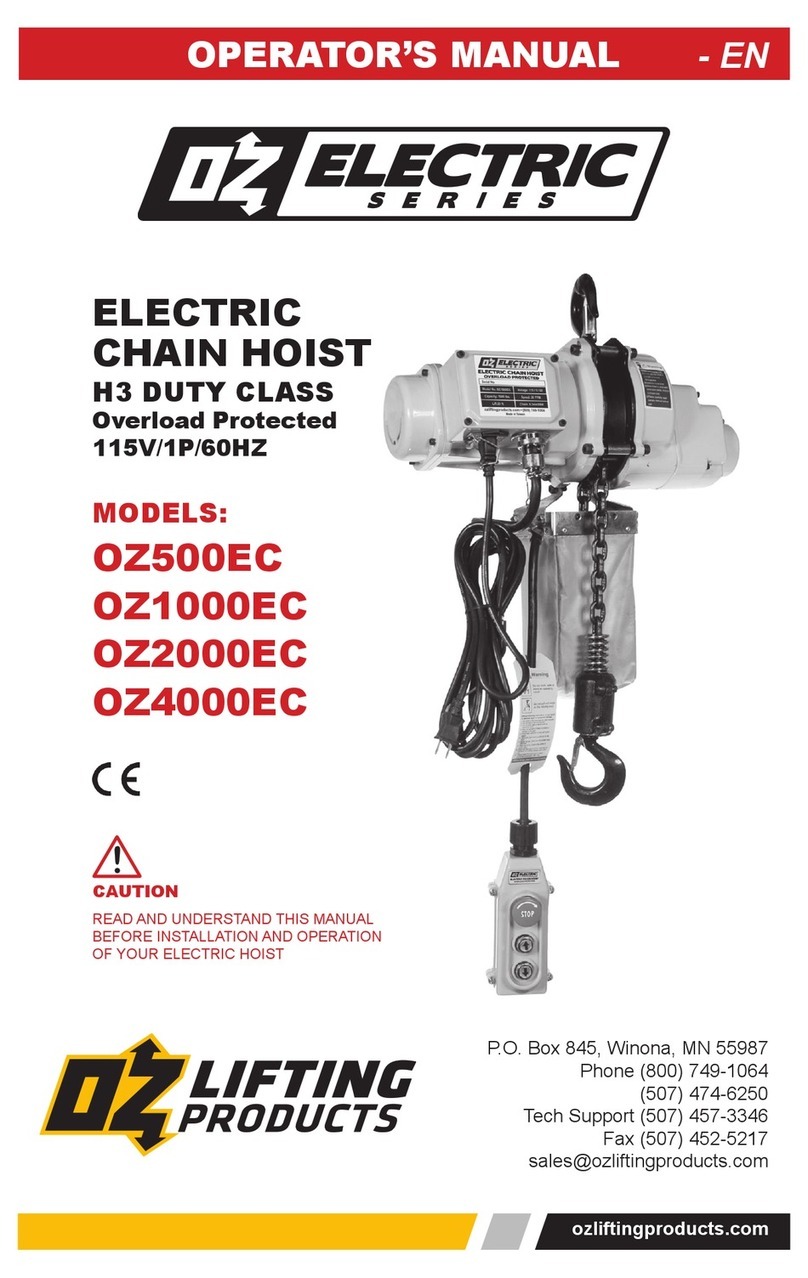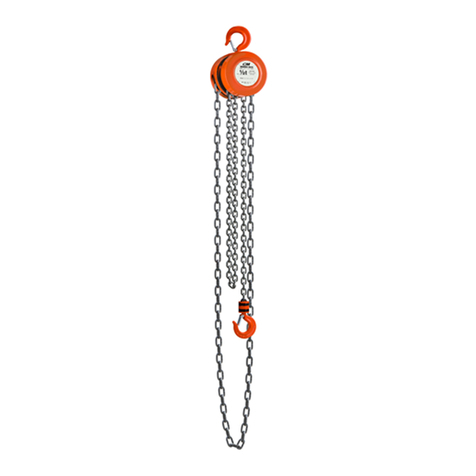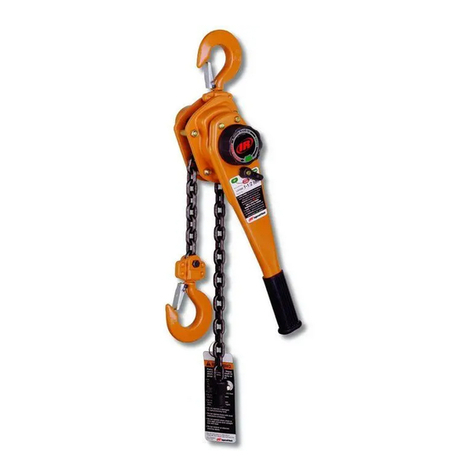Beaver 3S 503025 Guide

250KG, 500KG, 1 TONNE, 2 TONNE, 3 TONNE,
5 TONNE & 10 TONNE CAPACITIES.
250KG, 500KG, 1T, 2T, 3T, 5T & 10T CAPACITIES
Complies to AS 1418.2
BEAVER 3S
CHAIN BLOCK
OVERLOAD PROTECTION OPTIONAL
CHAIN BLOCK
SAFETY OPERATIONS & PARTS MANUAL
1300 783 606
www.beaver.com.au

2I CHAIN BLOCK SAFETY OPERATIONS & PARTS MANUAL
CHAIN BLOCK
This manual contains important information to help you properly install,
operate and maintain your 3S chain block for maximum performance,
economy and safety. Please study its contents thoroughly before putting
your chain block into operation. By practicing correct operating procedures
and by carrying out the recommended preventative maintenance
suggestions, you will be assured of long, dependable and safe service.
After you have completely familiarised yourself with the contents of this
manual, we recommend that you carefully file it for future reference.
The information herein is directed to the proper use, care and maintenance
of the 3S chain block and does not comprise a handbook on the broad
subject of rigging. Rigging can be defined as the process of lifting and
moving heavy loads using hoists and other mechanical equipment. Skill
acquired through specialised experience and study is essential to safe
rigging operations. For rigging information, we recommend consulting a
standard textbook on the subject.
UNPACKING
After opening the carton, the chain block should be carefully inspected
for damage which may have occurred during shipment or handling. Check
the chain block frame for dents or cracks and inspect the load chain for
nicks and gouges. If shipping damage has occurred, contact your local
supplier or Beaver Brands Sales Office.
WARNING
Operating a unit with obvious external damage may
cause load to drop and that may result in personal
injury and/or property damage.
TO AVOID INJURY
Carefully check unit for external damage prior to installation.
OPERATING INSTRUCTIONS
After mounting and before
placing in service, check the
chain block for proper operation.
To operate the chain block, pull
on the hand chain as indicated.
Operate the chain block with
no load and then a light load of
approximately 20kg. To make
sure it operates properly and
the brake holds the load when
the hand chain is released, then
operate with a rated load as
shown on the capacity plate.
WARNING
TO AVOID INJURY
Stop operating in the lifting
direction when the hook block
contacts the hoist frame and /
or hanger, as noted by sudden
increase in hand chain pull or
tipping of the hook block.
Upper Hook
Chain Block
Frame
Loose end
Chain
Load Chain
Safety
Warnings
Tube
Hook Latch
Lower Hook
To lower hoo
k
pull on this
part of Hand
Chain
To raise
hook pull on
this part of
Hand Chain
Hand Chain
GENERAL INFORMATION

CHAIN BLOCK SAFETY OPERATIONS & PARTS MANUAL I 3
CHAIN BLOCK
CHOOSE THE RIGHT CHAIN BLOCK FOR THE JOB
Choose a chain block with the capacity for the job. Know the capacities of
your loads, then match them. The application, the size and type of load,
the attachments to be used and the period of use must also be taken into
consideration in selecting the right chain block for the job.
Remember the chain block was designed to ease our burden, and
carelessness not only endangers the operator, but in many cases, a
valuable load.
INSPECT
All chain blocks should be visually inspected before use, in addition
to regular periodic maintenance inspections. Inspect chain block for
operations warning notices and legibility. Deficiencies should be noted
and brought to the attention of supervisors. Be sure defective chain
blocks are tagged and taken out of service until repairs are made.
Under no circumstances should you operate a malfunctioning chain block.
Check for gouged, twisted, distorted links and foreign material. Do not
operate chain blocks with twisted, kinked or damaged chain links. Load
chain should be properly lubricated. Hooks that are bent, worn or whose
openings are enlarged beyond normal throat opening should not be used.
If latch does not engage in throat opening of hook, chain block should be
taken out of service. Chains should be checked for deposits of foreign
material, which may be carried into the chain block mechanism. Check
brake for evidence of slippage under load.
Each Beaver 3S Chain Block is built in accordance with the specifications
contained herein and at time of manufacture complies with our
interpretation of applicable sections of the Australian Standard AS1418.2.
*Copies of this standard can be obtained from Standards Australia.
The symbol points out important safety instructions which if not
followed could endanger the personnel safety and / or property of
yourself and others. Read and follow all instructions in this
manual and any provided with the equipment before attempting
to operate your Beaver Chain Block.
Consult Beaver Brands for any usage of Beaver 3S Chain Blocks that
does not involve raising of the load on the lower hook, or usage of the
chain blocks in the inverted position. Using chain blocks without special
precautions, in such applications may cause an accident that could result
in injury and/or property damage.
DO’S AND DO NOT’S
Safe Operation of Chain Blocks
The following are Do’s and Do Not’s for safe operation of overhead chain
blocks. Taking precedence over any specific rule listed here, however, is
the most important rule of all, use common sense. A few minutes spent
reading these rules can make an operator aware of dangerous practices
to avoid and precautions to take for his own safety and the safety of
others. Frequent examination and periodic inspections of the equipment
as well as a conscientious observance of safety rules may save lives as
well as time and money.
SAFETY INFORMATION & PRECAUTIONS

4I CHAIN BLOCK SAFETY OPERATIONS & PARTS MANUAL
CHAIN BLOCK
WARNING
TO AVOID INJURY
1. DO be familiar with chain block operating controls, procedures and
warnings.
2. DO make sure the chain block suspension hook is securely attached
to a suitable support.
3. DO maintain a firm footing or be otherwise secured when operating
chain block.
4. DO make sure that load slings or other approved sling attachments
are properly sized and seated in the hook saddle.
5. DO make sure that the hook latch, is closed and not supporting any
part of the load.
6. DO make sure that the load is free to move and will clear all
obstructions.
7. DO take up slack chain carefully, check load balance, lift a few
centimetres and check load holding action before continuing.
8. DO make sure that all persons stay clear of the suspended load.
9. DO avoid swinging of load or load hook.
10. DO protect load chain from weld spatter or other damaging
contaminants.
11. DO promptly report any malfunction, unusual performance, or
damage of the chain block.
12. DO inspect chain block regularly, replace damaged or worn parts
and keep appropriate records of maintenance.
13. DO use Beaver genuine parts when repairing a chain block.
14. DO use hook latches wherever possible.
15. DO apply lubricant to the load chain as recommended in this manual.
16. DO replace damaged or malfunctioning hook latch.
17. DO NOT lift more than rated load.
18. DO NOT use damaged chain block or chain block that is not working
correctly.
19. DO NOT use the chain block with twisted, kinked, damaged or worn
chain.
20. DO NOT lift a load unless chain is properly seated in chain wheel(s).
21. DO NOT use load chain as a sling or wrap chain around load.
22. DO NOT lift a load if any binding prevents equal loading on all
supporting chains.
23. DO NOT apply the load to the tip of the hook.
24. DO NOT operate unless load is centred under chain block.
25. DO NOT operate chain block with other than manual power.
26. DO NOT permit more than one operator to pull on a single hand chain
at one time.
27. DO NOT allow your attention to be diverted from operating the chain
block.
28. DO NOT operate the chain block beyond limits of load chain travel.
29. DO NOT use chain block to lift, support or transport people.
30. DO NOT lift loads over people.
31. DO NOT leave a suspended load unattended unless specific
precautions have been taken.
32. DO NOT allow sharp contact between two chain blocks or between
chain block and obstructions.
33. DO NOT allow the chain or hook to be used as a earth for welding.
34. DO NOT allow the chain or hook to be touched by a live welding
electrode.
35. DO NOT remove or obscure the warnings on the chain block.
36. DO NOT adjust or repair a chain block unless qualified to perform
chain block maintenance.
37. DO NOT attempt to lengthen the load chain or repair damaged load
chain.
SAFETY PRECAUTIONS & PROCEDURES

CHAIN BLOCK SAFETY OPERATIONS & PARTS MANUAL I 5
CHAIN BLOCK
SAFETY PROCEDURES
The chain block must always be rigged to lift in a straight line from hook
to hook. The chain block must always be free to swivel on the upper hook.
Under no conditions should the chain block frame be allowed to bear on
any support when in use as this would cause bending of the hook or frame
and damage the unit.
When preparing to lift or move a load, be sure that the attachments to
both hooks are firmly seated in the saddles of the hooks. Avoid off centre
loading of any kind especially loading on the tip of the hook. Also observe
that the chain hangs straight (without twists) from chain block to lower
hook.
When lifting, raise the load only enough to clear the floor or support and
check to be sure brake will hold the load and that attachments to the load
are firmly seated. Continue the lift only after you are assured the load is
free of all obstructions.
Do not load beyond the rated
capacity of the chain block. Rated
capacity can be achieved with
the following hand chain pulls.
Since these hand chain pulls can
easily be applied by one person,
under no circumstances should
more than one person operate
the hoist hand chain. Overloading
can cause immediate failure of
some load carrying parts or result
in damage causing failure at less than rated capacity. When in doubt use
the next largest capacity Beaver 3S Chain Block.
WARNING Exceeding the rated capacity of the chain block
may cause load to fail.
TO AVOID INJURY
Do not exceed the hand chain pulls specified in safety procedure 4.
5. Do not wrap load chain around the load or bring the load in contact
with the chain block. Doing this will result in the loss of the swivel
effect of the hook which could mean twisted chain and jammed
liftwheel. The chain could be damaged at the hook.
6. Stand clear of all loads and avoid moving load over the heads of
other personnel. Warn personnel of your intention to move a load
in their area.
7. Do not leave the load in the air unattended.
8. Do not lower the hook to a point where the chain becomes taut
between the liftwheel and loose end pin.
9. Do not run the lower hook block into the chain block frame. Frame
and /or chain guide damage may result.
10. The chain block has been designed for manual operation only.
WARNING SPECIAL NOTE FOR USER:
TWISTING OF CHAIN
5 and 10 tonne 3S Chain Blocks have multiple falls of load chain.
THE LOAD CHAIN MUST BE INSPECTED FOR TWIST PRIOR TO EACH LIFT.
If the chain block bottom hook has looped through the multi fall of load
chain this can create a twist in the load chain that can damage the chain
block and cause injury.
Chain Block
Rated Load (kg)
Hand Chain Pull to
Lift Rated Load (N)
250 300
500 240
1000 250
2000 335
3000 363
5000 360
10000 380
SAFETY PROCEDURES

6I CHAIN BLOCK SAFETY OPERATIONS & PARTS MANUAL
CHAIN BLOCK
DO NOT leave a load suspended on the
chain block unattended.
DO NOT wrap the load chain around the load
and hook onto itself as a choker chain or bring
the load in contact with the chain block.
DO NOT heat treat and DO NOT weld any part
of the chain block, expecially the load chain.
DO NOT hold the load chain in a loaded state
while operating the chain block as serious injury
may occur if the brake did not operate properly.
DO NOT attempt to lift load
beyond the rated capacity.
IMPORTANT SAFETY WARNINGS

CHAIN BLOCK SAFETY OPERATIONS & PARTS MANUAL I 7
CHAIN BLOCK
DO NOT use the chain block for lifting
or moving people, or lifting loads
over people.
DO NOT run the hook assembly
into the frame of the block.
DO NOT operate the chain block unless
it is rigged to pull in a straight line from
hook to hook,and the frame is allowed
to freely swivel on the upper hook.
DO NOT shock load chain
block,chain or hook.
IMPORTANT SAFETY WARNINGS

8I CHAIN BLOCK SAFETY OPERATIONS & PARTS MANUAL
CHAIN BLOCK
INSPECTION
To maintain continuous and satisfactory operation, a regular inspection
procedure must be initiated so that worn or damaged parts can be
replaced before they become unsafe. The intervals of inspection must be
determined by the individual application and are based upon the type of
service to which the chain block will be subjected. The inspection of chain
blocks is divided into two general classifications designated as frequent
and periodic.
FREQUENT INSPECTIONS
These inspections are usually visual examinations by the operator or other
designated personnel. The frequent inspections are to be performed daily
or monthly and shall include the following items:
A. Braking mechanism for evidence of slippage - Daily.
B. Load chain for lubricant, wear, damaged links or foreign material -
Daily.
C. Hooks for damage, cracks, twists, latch engagement and latch
operation - Monthly. Any deficiencies noted are to be corrected before
the chain block is returned to service.
PERIODIC INSPECTIONS
These are visual inspections by an appointed person who makes records
of apparent external conditions to provide the basis for a continuing
evaluation.
For normal service, the periodic inspections are to be performed yearly
and for heavy service, the periodic inspections are to be performed semi-
annually.
Due to the construction of the chain block, it will be necessary to
particularly disassemble the unit to perform the periodic inspections.
The periodic inspections are to include those items listed under frequent
inspections as well as the following:
A. Chain for excessive wear or stretch.
B. Worn, cracked or distorted parts such as hook blocks, chain guide,
stripper, loose end pin, shafts, gears, hook collar and bearings.
C. Inspect for wear on the tip of the pawl, teeth of the ratchet and pockets
of the liftwheel and hand-wheel.
D. Loose or missing bolts, nuts, pins or rivets.
E. Inspect brake components for worn, glazed or contaminated friction
discs.
F. Corroded, stretched or broken pawl spring.
Free movement of the pawl on the pawl stud. Also, apply a thin coat of
lubricant to the pawl stud before reassembling the unit.
Hooks - dye penetrant, magnetic particle or other suitable crack-
detecting inspections should be performed at least once a year, if external
conditions indicate there has been unusual usage.
Any deficiencies noted are to be corrected before the chain block is
returned to service. Also, the external conditions may show the need for a
detailed inspection which,in turn, may require the use of non destructive-
type testing.
Any parts that are deemed unserviceable are to be replaced with new
parts before the unit is returned to service. It is very important that the
unserviceable parts be destroyed to prevent possible future use as a
repair item and properly disposed of.
MAINTENANCE
NOTE: Only qualified personnel to perform chain
block maintenance.
WARNING

CHAIN BLOCK SAFETY OPERATIONS & PARTS MANUAL I 9
CHAIN BLOCK
HOOK INSPECTION
Hooks damaged from chemicals, deformations or cracks that have more
than a 10º twist from the plane of the unbent hook or excessive opening
or seat wear must be replaced.
Also, hooks that are opened and those that allow the latch to disengage
the tip, must be replaced. Any hook that is twisted or has excessive throat
opening or eat wear must be replaced.
Any hook that is twisted or has excessive throat opening, indicates abuse
or over loading of the unit. Other load sustaining components of the chain
block should be inspected for damage. The chart above should be used to
determine when the hook must be replaced. To measure throat opening,
depress the latch against the hook body as shown above.
Also check to make sure that the latch is not damaged or bent and that
it operates properly with sufficient spring pressure to keep the latch
tightly against the tip of the hook and allow the latch to spring back to
the tip when released. If the latch does not operate properly, it should be
replaced.
LOAD CHAIN
Cleaning and Inspection
First clean the load chain with a non-acid or non-caustic type solvent
then slack the chain and make a link by link inspection for nicks, gouges,
twisted links and excessive wear or stretching.
Worn chain should be gauged throughout its entire length and replaced if
beyond serviceable limits.
Measure
Opening
Hook Throat Opening
Twisted
DO NOT USE
Normal
CAN BE USED
10˚ Max.
Number of
Links in Gauge
Gauge
Length
Measure
Opening
Hook Throat Opening
Twisted
DO NOT USE
Normal
CAN BE USED
10˚ Max.
Number of
Links in Gauge
Gauge
Length
MAINTENANCE

10 I CHAIN BLOCK SAFETY OPERATIONS & PARTS MANUAL
CHAIN BLOCK
To determine if load chain should be continued in service, check gauge
lengths as indicated below. Chain worn beyond length indicated,
nicked, gouged or twisted should be replaced before returning chain
block to service. Chain should be clean, free of twists and pulled taut
before measuring. In cases where the wear is localised and not beyond
serviceable limits, it is sometimes possible to reverse the load chain, end
for end and allow a new section to take the wear. Proper installation of
the load chain is covered in the section on Reeving Load Chain (page 12).
Note that worn chain can be an indication of worn chain block components.
For this reason, the chain block’s chain guide roller and lift wheel should
be examined for wear and replaced as necessary when replacing worn
chain.
Also load chains are specially heat treated and hardened and should never
try to be repaired.
WARNING
Using chain other than Beaver’s supplied load chain may cause the chain to
jam in the chain block and/or allow the chain to break and the load to drop.
TO AVOID INJURY
Due to the size requirements and physical properties, use only Beaver
Alloy Load Chain in the 3S Chain Block.
Important. Do not use replaced chain for other purposes such as
lifting or pulling. Load chain may break suddenly without visual
deformation. For this reason, cut replace chain into short lengths to
prevent use after disposal.
Before returning chain to service or after replacing a load chain, lubricate
liberally with chain oil or equal lubricant. Remove excess lubricant from
the chain by wiping with a cloth.
HAND CHAIN
Hand Chain should be cleaned, inspected and gauged in the same manner
as load chain.
As received from the factory, the hand chain may contain an unwelded
link. This link can be placed in a vice and twisted open to facilitate
changing chain length.
Please note that opening and closing of the connecting link more than
twice is not recommended. Also, connecting links must not be made by
cutting the weld side of a standard hand chain link.
Hand chain should be assembled to hand wheel free from twists with
weld on vertical link facing inwards towards hand wheel and weld on
horizontal link facing towards the hand wheel side plate.
Care must be taken to assure that there is no twist in the hand chain loop.
MAINTENANCE

CHAIN BLOCK SAFETY OPERATIONS & PARTS MANUAL I 11
CHAIN BLOCK
LUBRICATION
Lubricate load chain with a light coat of chain oil or equal lubricant.
Be sure the lubricant reaches the bearing surfaces between the links.
Remove excess oil from the chain.
WARNING Used motor oil contains unknown carcinogenic
materials.
TO AVOID HEALTH PROBLEMS
Never use used motor oils as a chain lubricant. Only use chain oil as a
lubricant for the load chain.
The chain block normally requires no additional lubricant except for
periodically lubricating the load chain as indicated or when the unit is
disassembled for periodic inspections, cleaning or repairs.
The brake is designed to operate dry. Do not use any grease or
lubricant on the braking surfaces. When lubricating parts adjacent
to the brake, do not use an excessive amount of lubricant which
could seep onto the brake surface.
WARNING Using any grease or lubricant on the braking surfaces
will cause brake slippage and loss of load control
which may result in injury and/or property damage.
TO AVOID INJURY
Do not use any grease or lubricant on the braking surfaces. The brake is
designed to operate dry.
When the chain block is disassembled for periodic inspections, check
the pawl for free movement and apply a light coat of WD-40 or similar
lubricant to the pawl stud. When the chain block is disassembled for
cleaning or repairs, the following locations should be lubricated using
approximately 29.5ml per chain block of suitable grease or equivalent:
•GEARS •LIFTWHEEL ROLLERS •GEAR BEARING ROLLERS •CHAIN
GUIDE & DEAD END PIN
Note: To assure extra long life and top performance, be sure to lubricate the
various parts of the chain block using the lubricant specified above.
INSERT IMAGE OF CHAIN BLOCK IN USE
OR SOMETHING
MAINTENANCE

12 I CHAIN BLOCK SAFETY OPERATIONS & PARTS MANUAL
CHAIN BLOCK
ASSEMBLY
Consideration must be given to the following when assembling the chain
block:
1. Assemble the brake components
as shown below. The ratchet teeth
must face, as shown and engage
the pawl. Do not lubricate the brake
surfaces. The brake operates dry.
Assemble hand-wheel to pinion
shaft and turn hand-wheel to seat
brake components. Assemble the
pinion shaft nut to the shaft until
the nut bottoms. Then back nut
off at least one but not more than
two flats. Insert cotter pin and bend
ends to secure same.
2. The intermediate gears have
timing marks (letter ‘O’ stamped
on one tooth). The gears must be
assembled with these marks orientated as shown below.
3. For proper operation, the correct number of rollers must be installed at
the rotating points of the liftwheel, intermediate gears.
Refer to Disassembly Instructions (page 11) for the number of rollers
at these locations. Applying grease or equal lubricant to the rollers or
bearing balls will help hold them in position during assembly.
4. When assembling the latch to the hook, the end of the rivet must be
peened over. When peening over the rivet, only apply enough force to form
the head and retain the rivet.
Excessive force will deform the latch and make the latch inoperable.
REEVING LOAD CHAIN
A. 250, 500, 1000, 2000 and 3000Kg Chain Blocks.
Attach approximately 500mm of soft wire to the loose end of the chain.
Pass the wire over the top of the liftwheel and down between the liftwheel
and the chain guide. Position the chain so that the first, as well as the
third, link stands on edge with the weld away from the liftwheel and the
second link lays flat on the liftwheel. After the chain has been started,
pull hand chain in the hoisting direction until about 0.6m of chain has
passed the liftwheel. The wire should now be removed from the chain.
Remove the cotter pin from the loose end pin and slide the loose end pin
to the side into the bear housing leaving approximately 12.7mm of the pin
protruding from the geared side plate. Loop the chain, making sure there
are no twists, up to the loose end pin and slide the pin through the last link
of the chain. Slide the loose end pin into hole in the hand-wheel side plate
until the cotter pin hole is visible. Secure the loose end pin by reinstalling
the cotter pins and spreading the legs of the cotter pins.
5 and 10 tonne chain blocks have multiple falls and are required to be
reeved by Beaver Sales or our authorised dealers only.
WARNING Failure to properly
install the load chain
between guide and
liftwheel may cause the chain to lift out of the
liftwheel pockets and allow the load to drop.
TO AVOID INJURY
Feed load chain between liftwheel and chain
guide as shown above before attaching it to
the loose end pin.
Ratchet
Ratchet
Friction
Washer
Friction
Hub
Pawl
Intermediate
Gear
Timing
Marks
Loose
End Pin
Chain
Guide
Liftwheel
Ratchet
Ratchet
Friction
Washer
Friction
Hub
Pawl
Intermediate
Gear
Timing
Marks
Loose
End Pin
Chain
Guide
Liftwheel
MAINTENANCE

CHAIN BLOCK SAFETY OPERATIONS & PARTS MANUAL I 13
CHAIN BLOCK
EXTERIOR FINISH
The exterior surfaces of the chain blocks have a durable, scratch resistant
finish. Normally, the exterior surfaces can be cleaned by wiping with a cloth.
RECOMMENDED SPARE PARTS
To insure continued operation it is recommended that two friction washers
for each 3S chain block in service, Key no ‘P’, be kept on hand at all times to
replace friction washers that are worn, contaminated or glazed. Contact your
nearest Beaver Sales office for details.
PREVENTATIVE MAINTENANCE
In addition to the periodic inspection procedure, a preventative maintenance
program should be established to prolong the useful life of the chain block and
maintain its dependability and continued safe use. The program should include
the periodic inspections with particular attention being paid to the lubrication
of various components using the recommended lubricants.
TESTING
Before using, all altered, repaired or used chain blocks that have not been
operated for the previous 12 months, should be tested by the user for proper
operation.
First test the unit without a load and then with a light load of 20 kg to be sure
that the chain block operates properly and that the brake holds the load when
the hand chain is released.
Next test with a load of 100% rated capacity.
In addition, chain blocks in which load sustaining parts have been replaced
should be tested with 100% of rated capacity by or under the direction of an
appointed person and a written report prepared for record purposes.
ORDERING INFORMATION
The following information must accompany all correspondence
or repair parts orders:
• Chain Block capacity
• Serial Number - stamped on the capacity label
For parts orders also specify:
• Quantity desired
• Key number of part
• Part name
• Part number
When ordering replacement parts, consideration should be given to the
need to replace other items, (springs, fasteners etc) and items that may
be damaged or lost during disassembly or just unfit for future use because
of deterioration from age or service.
Parts should be ordered from Beaver Sales Australia or Beaver’s Service
Agents. Using ‘commercial’ or other manufacturer’s parts to repair the
Beaver 3S Chain Block may cause load loss.
WARNING
TO AVOID INJURY
Use only Beaver supplied replacement parts. Parts may look alike, but
Beaver Sales parts are made of specific materials or processed to achieve
specific properties.
MAINTENANCE

14 I CHAIN BLOCK SAFETY OPERATIONS & PARTS MANUAL
CHAIN BLOCK
Product Code 503025
Rated capacity (kg) 250
Colour Silver
Standard Lift (m) 1.5
Fall of Chain 1
Efforts to lift full load (N) 300
Net Weight 3.5
Load Chain Diameter (mm) 4x12
Extra weight per metre of
extra lift (kg) 0.54
Headroom (H) 230
Dimension (mm)
A110
B100
C18
250kg Capacity
WARNING
OVERLOAD PROTECTION UNAVAILABLE ON 5036025. NOT SUITABLE FOR UNDERGROUND MINING
250KG SPECIFICATIONS & DIMENSIONS


16 I CHAIN BLOCK SAFETY OPERATIONS & PARTS MANUAL
CHAIN BLOCK
Product Code 503053 503103 503203 503303 503503 503603
Product Code
Overload Model 508053 508103 508203 503303 508503 508603
Rated capacity
(kg) 500 1000 2000 3000 5000 10000
Colour White Violet Green Yellow Red Orange
Standard Lift (m) 333333
Fall of Chain 111224
Efforts to lift full
load (N) 240 250 335 335 363 380
Net Weight (kg) 11 12.5 19.5 29 41.3 78.5
Load Chain
Diameter (mm)
5x15
Grade 80
6x18
Grade 80
8x24
Grade100
8x24
Grade 80
10x30
Grade 80
10x30
Grade 80
Extra weight per
metre of extra lift
(kg)
0.55 0.79 1.38 2.76 4.4 8.8
Headroom (H) 345 376 470 565 688 765
Dimension (mm)
A132 151 175 176 189 189
B148 172 210 230 280 463
C 28 32 36 46 46 57
500KG - 10 TONNE SPECIFICATIONS

CHAIN BLOCK SAFETY OPERATIONS & PARTS MANUAL I 17
CHAIN BLOCK
500KG, 1 & 2 TONNE 3 & 5 TONNE 10 TONNE
500KG - 10 TONNE SPECIFICATIONS

18 I CHAIN BLOCK SAFETY OPERATIONS & PARTS MANUAL
CHAIN BLOCK
Name Plate Assembly Key # QTY
Name Plate Rivet 2mm 1 5
Name Plate 2 1
Capacity Plate 40 1
Cover Plate Assembly Key # QTY
Gear Case Cover Nut 3 3
Gear Case Cover Spring Washer 4 3
Gear Case Assembly 5 1
Gear Case Cover Steel Ring 6 2
Brake Disc Cover 35 1
Brake Disc Cover Stay 36 3
Hand Wheel Cover 39 1
Gear Assembly Key # QTY
Disc Gear Assembly 7 2
Pinion Shaft 8 1
Pinion Shaft Washer 9 1
Splined Gear 10 1
Left Side Plate Assembly Key # QTY
Gear Case Cover Steel Ring 6 2
Left Side Plate 11 1
Bearings 12 1
Stripper 13 1
Stay of Left Plate 14 3
Load Chain Cover 19 1
Chain Sprocket 17 1
Friction Disc 32 2
Right Plate Assembly Key # QTY
Bearings 12 2
Right Side Nut M5 23 1
Gear Case Cover Spring Washer 4 1
Top Hook Pin 25 1
Pawl Spring 26 1
Pawl Washer 27 1
Pawl 28 1
Pawl Pin 29 1
Load Chain Pin 31 1
Right Side Plate 24 1
Hand Wheel Assembly Key # QTY
Brake Set 30 1
Ratchet Disc Ring 33 1
Ratchet Disc 34 1
Hand Wheel 38 1
Castle Nut Assembly Key # QTY
Capacity Plate Washer 41 1
Hex Castle Nut M8 42 1
Split Pin 43 1
Anchor Assembly Key # QTY
End Anchor 20 1
End Anchor Pin 21 1
Load Chain Split Pin 22 1
Hand Chain 37 1
Latch Kit 44 2
Key # QTY
Top Hook Assembly c/w Latch Kit 15 1
Bottom Hook Assembly c/w Latch Kit 16 1
Load Chain 18 1
Part Name 250kg
Name Plate Assembly 503025-1
Cover Plate Assembly 503025-2
Gear Assembly 503025-3
Left Side Plate Assembly 503025-4
Top Hook Assembly 503025-5
Bottom Hook Assembly 503025-6
Load Chain 503025-7
Right Plate Assembly 503025-8
Hand Wheel Assembly 503025-9
Castle Nut assembly 503025-10
Anchor Assembly 503025-11
Chain Sprocket 503025-12
End Anchor 503025-13
Friction Disc 503025-14
Hand Chain 503025-15
Latch Kit 503025-16
250KG CHAIN BLOCK SPARE PARTS

CHAIN BLOCK SAFETY OPERATIONS & PARTS MANUAL I 19
CHAIN BLOCK
Top Hook Bottom Hook
250KG CHAIN BLOCK SPARE PARTS

20 I CHAIN BLOCK SAFETY OPERATIONS & PARTS MANUAL
CHAIN BLOCK
Cover Assembly Key # QTY
Hand Wheel Cover Nut 1 3
Hand Wheel Cover 2 1
Brake Disc Cover 7 1
Gear Case 40 1
Gear Assembly Screws 41 3
Overload Protection Assembly Key # QTY
Locking Nut-Overload protection 6-1 1
Brake Set Ring-Overload protection 6-2 1
Spring Ring-Overload protection 6-3 1
Clamp-Overload protection 6-4 1
Friction Disc-Overload protection 6-5 1
Roll Pin-Overload protection 6-6 3
Ratchet Gear-Overload protection 6-7 1
Brake Set-Overload protection 6-8 1
Left Plate Assembly Key # QTY
Snap Ring Bearing 11 2
Pawl 12 2
Pawl Spring 13 2
Screw Locking Plate 14 1
Spring Washer Plate 15 1
Lock Plate 16 1
Left Side Plate 17 1
Top Hook Pin 18 1
Ball Bearing A 21 1
Snap Ring A 22 1
Right Plate Assembly Key # QTY
Snap Ring 22 1
Ball Bearing B 27 1
Stripper 28 1
Right Side Plate 33 1
Gear Assembly Key # QTY
Disc Gear Assembly 34 2
Splined Gear 35 1
Snap Ring B 36 1
Pinion Shaft 37 1
Snap Ring D 38 1
Ball Bearing D 39 1
Sprocket Assembly Key # QTY
Snap Ring C 23 1
Ball Bearing C 24 1
Chain Sprocket 25 1
Etch Plate Assembly Key # QTY
Name Plate 42 1
Name Plate Rivets 43 1
Brake Set Assembly Key # QTY
Ratchet Disc 9 1
Brake Set 10 1
Anchor Assembly Key # QTY
Suspension Plate Pin 29 1
Split Pin 30 1
End Anchor 31 1
Top Hook Assembly 19 1
Hand Wheel Sprocket Without Overload
Protection 6a 1
Bottom Hook Assembly 20 1
Load Chain 26 1
Split Pin 3 1
Guide Roller 32 2
Hand Chain 5 1
Latch Kit 44 2
Latch Kit Bolt 44A 1
Latch Kit Spring 44B 1
Latch Kit Nut 44C 1
Hexagonal Slotted Nut 4 1
Friction Disc 8 2
500KG - 10 TONNE CHAIN BLOCK SPARE PARTS
This manual suits for next models
11
Table of contents
Popular Chain Hoist manuals by other brands

Hubbell
Hubbell CHANCE 3011S Operating and service instructions

CMCO
CMCO Yale VSIII 0,25/1 operating instructions

POWERTEX
POWERTEX PGT-S2 user manual

OZ Lifting Products
OZ Lifting Products OZ500EC Operator's manual

Ingersoll-Rand
Ingersoll-Rand 7700-E Series Installation, operation and maintenance instructions

Yale
Yale UNOplus Translated Operating Instructions

Harrington
Harrington CF4 owner's manual

Coffing Hoists
Coffing Hoists EC Series Operating, Maintenance & Parts Manual

CM
CM 622A Series Operating, Maintenance & Parts Manual

Guldmann
Guldmann DH 2000 manual

Ingersoll-Rand
Ingersoll-Rand LV Series Installation and operation manual

Toku
Toku TCR Series instruction manual





